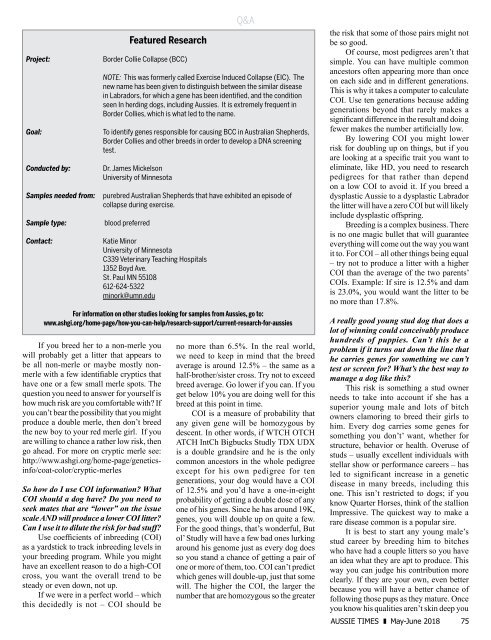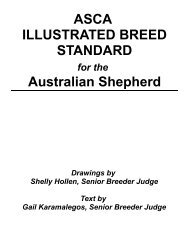2018 May June
You also want an ePaper? Increase the reach of your titles
YUMPU automatically turns print PDFs into web optimized ePapers that Google loves.
Project:<br />
Goal:<br />
Conducted by:<br />
Samples needed from:<br />
Sample type:<br />
Contact:<br />
Featured Research<br />
Border Collie Collapse (BCC)<br />
Q&A<br />
NOTE: This was formerly called Exercise Induced Collapse (EIC). The<br />
new name has been given to distinguish between the similar disease<br />
in Labradors, for which a gene has been identified, and the condition<br />
seen In herding dogs, including Aussies. It is extremely frequent in<br />
Border Collies, which is what led to the name.<br />
To identify genes responsible for causing BCC in Australian Shepherds,<br />
Border Collies and other breeds in order to develop a DNA screening<br />
test.<br />
Dr. James Mickelson<br />
University of Minnesota<br />
purebred Australian Shepherds that have exhibited an episode of<br />
collapse during exercise.<br />
blood preferred<br />
Katie Minor<br />
University of Minnesota<br />
C339 Veterinary Teaching Hospitals<br />
1352 Boyd Ave.<br />
St. Paul MN 55108<br />
612-624-5322<br />
minork@umn.edu<br />
For information on other studies looking for samples from Aussies, go to:<br />
www.ashgi.org/home-page/how-you-can-help/research-support/current-research-for-aussies<br />
If you breed her to a non-merle you<br />
will probably get a litter that appears to<br />
be all non-merle or maybe mostly nonmerle<br />
with a few identifiable cryptics that<br />
have one or a few small merle spots. The<br />
question you need to answer for yourself is<br />
how much risk are you comfortable with? If<br />
you can’t bear the possibility that you might<br />
produce a double merle, then don’t breed<br />
the new boy to your red merle girl. If you<br />
are willing to chance a rather low risk, then<br />
go ahead. For more on cryptic merle see:<br />
http://www.ashgi.org/home-page/geneticsinfo/coat-color/cryptic-merles<br />
So how do I use COI information? What<br />
COI should a dog have? Do you need to<br />
seek mates that are “lower” on the issue<br />
scale AND will produce a lower COI litter?<br />
Can I use it to dilute the risk for bad stuff?<br />
Use coefficients of inbreeding (COI)<br />
as a yardstick to track inbreeding levels in<br />
your breeding program. While you might<br />
have an excellent reason to do a high-COI<br />
cross, you want the overall trend to be<br />
steady or even down, not up.<br />
If we were in a perfect world – which<br />
this decidedly is not – COI should be<br />
no more than 6.5%. In the real world,<br />
we need to keep in mind that the breed<br />
average is around 12.5% – the same as a<br />
half-brother/sister cross. Try not to exceed<br />
breed average. Go lower if you can. If you<br />
get below 10% you are doing well for this<br />
breed at this point in time.<br />
COI is a measure of probability that<br />
any given gene will be homozygous by<br />
descent. In other words, if WTCH OTCH<br />
ATCH IntCh Bigbucks Studly TDX UDX<br />
is a double grandsire and he is the only<br />
common ancestors in the whole pedigree<br />
except for his own pedigree for ten<br />
generations, your dog would have a COI<br />
of 12.5% and you’d have a one-in-eight<br />
probability of getting a double dose of any<br />
one of his genes. Since he has around 19K,<br />
genes, you will double up on quite a few.<br />
For the good things, that’s wonderful, But<br />
ol’ Studly will have a few bad ones lurking<br />
around his genome just as every dog does<br />
so you stand a chance of getting a pair of<br />
one or more of them, too. COI can’t predict<br />
which genes will double-up, just that some<br />
will. The higher the COI, the larger the<br />
number that are homozygous so the greater<br />
the risk that some of those pairs might not<br />
be so good.<br />
Of course, most pedigrees aren’t that<br />
simple. You can have multiple common<br />
ancestors often appearing more than once<br />
on each side and in different generations.<br />
This is why it takes a computer to calculate<br />
COI. Use ten generations because adding<br />
generations beyond that rarely makes a<br />
significant difference in the result and doing<br />
fewer makes the number artificially low.<br />
By lowering COI you might lower<br />
risk for doubling up on things, but if you<br />
are looking at a specific trait you want to<br />
eliminate, like HD, you need to research<br />
pedigrees for that rather than depend<br />
on a low COI to avoid it. If you breed a<br />
dysplastic Aussie to a dysplastic Labrador<br />
the litter will have a zero COI but will likely<br />
include dysplastic offspring.<br />
Breeding is a complex business. There<br />
is no one magic bullet that will guarantee<br />
everything will come out the way you want<br />
it to. For COI – all other things being equal<br />
– try not to produce a litter with a higher<br />
COI than the average of the two parents’<br />
COIs. Example: If sire is 12.5% and dam<br />
is 23.0%, you would want the litter to be<br />
no more than 17.8%.<br />
A really good young stud dog that does a<br />
lot of winning could conceivably produce<br />
hundreds of puppies. Can’t this be a<br />
problem if it turns out down the line that<br />
he carries genes for something we can’t<br />
test or screen for? What’s the best way to<br />
manage a dog like this?<br />
This risk is something a stud owner<br />
needs to take into account if she has a<br />
superior young male and lots of bitch<br />
owners clamoring to breed their girls to<br />
him. Every dog carries some genes for<br />
something you don’t’ want, whether for<br />
structure, behavior or health. Overuse of<br />
studs – usually excellent individuals with<br />
stellar show or performance careers – has<br />
led to significant increase in a genetic<br />
disease in many breeds, including this<br />
one. This isn’t restricted to dogs; if you<br />
know Quarter Horses, think of the stallion<br />
Impressive. The quickest way to make a<br />
rare disease common is a popular sire.<br />
It is best to start any young male’s<br />
stud career by breeding him to bitches<br />
who have had a couple litters so you have<br />
an idea what they are apt to produce. This<br />
way you can judge his contribution more<br />
clearly. If they are your own, even better<br />
because you will have a better chance of<br />
following those pups as they mature. Once<br />
you know his qualities aren’t skin deep you<br />
AUSSIE TIMES <strong>May</strong>-<strong>June</strong> <strong>2018</strong> 75



